Understanding hawks’ hunting and feeding behaviors is essential in comprehending the ecological dynamics of these magnificent birds of prey. With their keen vision, remarkable flight capabilities, and powerful talons, Hawks have evolved to be efficient hunters in various habitats worldwide.
One fundamental question that arises when exploring the lives of these raptors is, “What does the hawk eat?” This query delves into the fascinating realm of their dietary preferences, hunting strategies, and the intricate balance they maintain within ecosystems.
In this article, we will delve into hawks’ hunting and feeding behaviors, exploring the diverse species and their ecological roles. By gaining insight into the dietary habits of hawks, we can appreciate their importance in maintaining the delicate balance of nature and their critical role as top predators in their respective habitats.
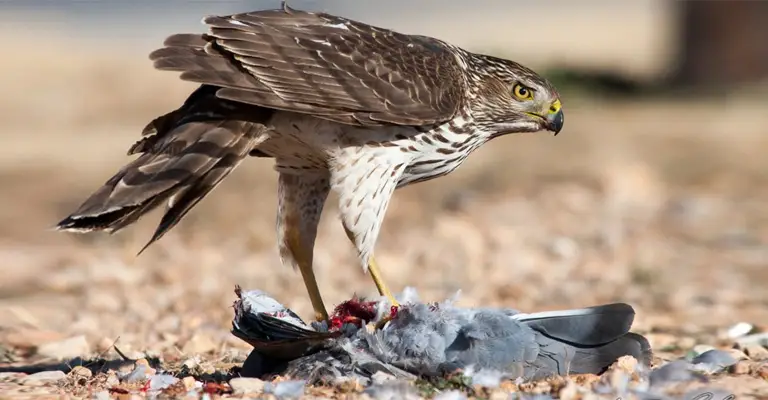
What Does The Hawk Eat- Hunting And Feeding Behaviors Of Hawks
Hawks are birds of prey that belong to the order Accipitridae, which includes eagles, kites, harriers, and vultures. They have sharp talons, hooked beaks, and keen eyesight that help them hunt and catch food.
Hawks are found in almost every continent except Antarctica and can adapt to different habitats and ecosystems. But what do hawks eat exactly? How do they find and capture their prey?
And do other species of hawks have different food preferences? In this article, we will explore these questions and learn more about the diet of these fascinating raptors.
Hawks are predatory animals that feed on various prey, depending on their size, species, and habitat. They are opportunistic hunters, which means they will eat whatever is available and easy to catch. Some of the common food groups that hawks eat are:
Small Mammals
Animals such as mice, rats, rabbits, squirrels, and bats make up some of the most popular foods among hawks. These animals are generally widespread and plentiful, so many species of hawks depend on them as a primary food source.
For example, red-tailed hawks prefer mice and rats but will eat many other types of mammals as well1.
Reptiles
Hawks in desert regions frequently eat lizards, snakes, and other small reptiles. Most reptiles are small and don’t provide a lot of meat, but again, hawks tend to take whatever they can get when hungry.
For example, Harris’s hawks often hunt in groups to catch more giant reptiles like rattlesnakes2.
Amphibians
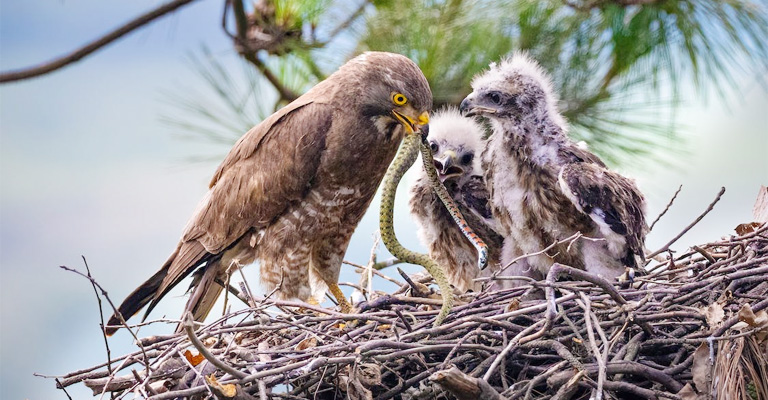
Frogs, toads, and salamanders make tasty treats for hawks living in wooded wetland regions. These animals are usually active at night or during rainy seasons, so hawks may have to adjust their hunting times to catch them.
For example, broad-winged hawks feed primarily on insects. Still, they will also eat frogs, lizards, mice, and other small animals to supplement their insect diet1.
Small Birds
Many hawks eat small and medium-sized birds such as jays, cuckoos, finches, and doves. Hawks living in urban areas may pick off these birds at bird feeders, while in the wild, they frequently capture them in midair or snag them from the ground or tree branches where they’re perched.
For example, Cooper’s hawks generally prefer birds -usually songbirds, though they have a reputation for going after chickens as well1.
Insects
Though most hawks prefer larger, meatier prey, some depend on insects to make up most of their diet. Nearly all hawks will eat insects to supplement their diet or if there is no better food.
Insects are abundant and easy to catch for hawks with agile flight skills and sharp vision. For example, Mississippi kites feed almost exclusively on insects such as dragonflies, grasshoppers, cicadas, and beetles2.
Hawks are excellent hunters that can adapt to different environments and prey types. They have a varied diet that ranges from small mammals to insects, depending on their species and habitat.
Hawks use their physical adaptations, such as nails, beaks, eyesight, and flight speed, to catch their food efficiently and effectively. By learning more about what hawks eat, we can appreciate their role in the ecosystem and their diversity as a group of birds.
Hunting Strategies Of Hawks
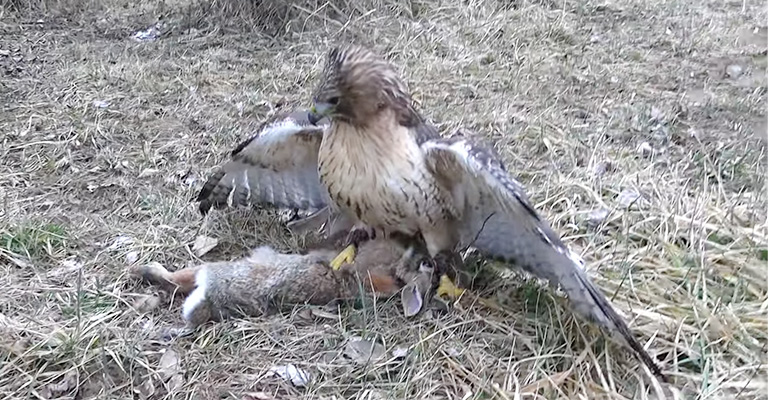
Hawks employ various hunting techniques that allow them to capture prey efficiently. Understanding these strategies provides valuable insights into their hunting prowess and adaptive behaviors.
From high-altitude hunting to perch and ground hunting, hawks have evolved distinct approaches to securing their meals.
High-Altitude Hunting: The Art Of Soaring And Stooping
Hawks are known for their exceptional aerial abilities, which they utilize during high-altitude hunting. They fly at great heights, scanning the ground below for potential prey.
Once a target is spotted, the hawk enters a rapid descent called stooping, employing gravity to increase its speed and strike with precision.
Perch Hunting: Waiting And Ambushing Prey
Another common hunting technique employed by hawks is perch hunting. Hawks select a strategic vantage point, such as a tree branch or utility pole, and patiently wait for prey to come within range.
With their sharp eyesight, they swiftly detect any movement and launch a surprise attack, capturing their unsuspecting prey.
Ground Hunting: Pursuing Prey On Foot
In certain situations, hawks resort to ground hunting, especially when pursuing small mammals or insects. They use their mighty wings to maneuver close to the ground and chase down prey on foot.
This method requires agility and speed, enabling hawks to seize their quarry through quick bursts of pursuit and skilled maneuvering.
Prey Selection of Hawks
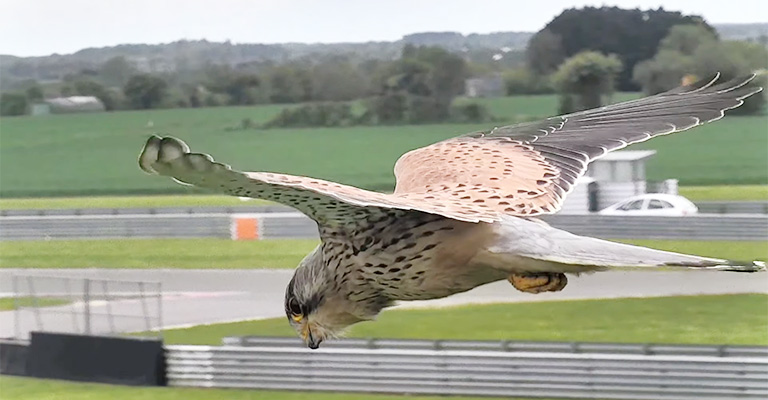
Hawks exhibit a remarkable ability to select their prey based on various factors, including the availability and suitability of potential targets.
Understanding the factors that influence prey selection by hawks provides valuable insights into their foraging behaviours and ecological interactions.
Factors Influencing Prey Selection By Hawks
Hawks consider several factors when choosing their prey. These include the abundance and accessibility of prey species, the habitat in which they reside, and the specific hunting techniques employed by each hawk species. Factors such as the hawk’s size, physical capabilities, and hunting efficiency also influence their prey selection.
Types Of Prey Commonly Targeted By Hawks
Hawks display various dietary preferences across different species and geographical locations. Small to medium-sized mammals such as rodents, rabbits, and squirrels often form a significant portion of their diet. Hawks also target birds, reptiles, amphibians, and occasionally insects.
Importance Of Size, Agility, And Prey Vulnerability
Hawks tend to prefer prey that offers a suitable balance between size, skill, and openness. While smaller prey items are easier to capture and handle, the giant game provides more nutrition.
Agility is crucial as hawks must pursue and capture their prey in flight or during swift ground chases. Prey vulnerability, such as injured or inexperienced individuals, can increase a hawk’s hunting success.
Feeding Behaviors of Hawks
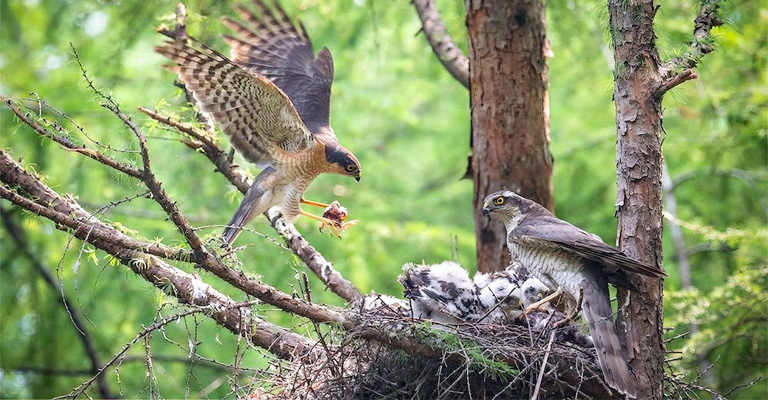
Hawks exhibit fascinating feeding behaviors that provide insights into their hunting prowess and parental care. Understanding their feeding techniques, prey handling, and nestling feeding rituals helps us appreciate their adaptability and survival strategies in different environments.
Hawk Feeding Techniques And Rituals
Hawks employ various feeding techniques, including tearing prey apart with their beaks, using their sharp talons to grasp and immobilize prey, and dismembering larger prey into manageable pieces.
These techniques vary depending on the size and type of target. They are often accompanied by specific rituals, such as plucking feathers or removing scales before consumption.
Handling And Consumption Of Prey
Once a hawk has successfully captured its prey, it will typically perch or find a secure location to consume it. Hawks use their sharp beaks to tear apart the flesh, starting with the most accessible parts, such as the head or limbs.
Before swallowing the meat, they may also use their beaks to remove any indigestible elements, such as fur or feathers.
Nestling Feeding And Parental Care
During the breeding season, hawks exhibit exceptional parental care. Both male and female hawks participate in providing food for their nestlings. The parents tear the prey into small, digestible pieces and feed them to their young.
As the nestlings grow, they gradually transition to self-feeding, mimicking their parents’ hunting and feeding behaviors.
Regurgitation And Pellet Formation
Like other birds of prey, Hawks regurgitate pellets containing indigestible parts of their prey, such as bones, fur, and feathers. These pellets, consisting of compacted undigested materials, are often found near their roosting or nesting sites.
Scientists can analyze these pellets to gain insights into hawks’ dietary habits and prey composition.
Food Storage And Caching
Some hawk species practice food storage or caching, particularly those inhabiting colder regions. They may store excess prey in hidden locations, such as tree cavities or rocky crevices, to be consumed later when food is scarce. This behavior ensures a steady food supply during harsh weather conditions or periods of low prey abundance.
Scavenging Behaviors
While hawks are primarily skilled hunters, they may also scavenge opportunistically. They are known to feed on carrion, taking advantage of the carcasses of larger animals or the remains left by other predators. Scavenging provides hawks with an additional food source and reduces competition with other predators.
Food Acquisition of Hawks
Hawks employ remarkable adaptations and strategies to secure their daily sustenance. Their exceptional eyesight and acute hearing are instrumental in locating prey from great distances, making them formidable hunters.
Once prey is spotted, hawks exhibit diverse pursuit and capture techniques, ranging from high-speed aerial dives to precise ground attacks. Furthermore, territory plays a crucial role in their food acquisition process, as hawks establish and defend hunting grounds to ensure a steady supply of prey.
Locating Prey: Hawk’s Keen Eyesight And Hearing
Hawks possess exceptional vision, allowing them to spot the slightest movements of potential prey on the ground or in the air. Their eyes are highly adapted to detect small rodents, birds, and other creatures from great heights, aiding in efficient target selection.
Additionally, their acute hearing complements their visual prowess, enabling them to detect faint sounds of prey rustling in vegetation or scurrying on the ground.
Hawk’s Pursuit And Capture Techniques
Once a target has been identified, hawks employ various pursuit and capture techniques tailored to their hunting environment and the nature of their prey.
Some species, like the Peregrine Falcon, are renowned for their high-speed stoops, reaching astonishing velocities while diving to catch avian prey midair.
On the other hand, forest-dwelling hawks may engage in agile aerial pursuits through dense foliage or execute precise ground strikes to capture small mammals.
Role Of Territory In Food Acquisition
Territoriality is a critical aspect of a hawk’s food acquisition strategy. Hawks establish and fiercely defend their territories, encompassing prime hunting grounds with prey.
By maintaining exclusive access to these areas, hawks can secure sufficient food resources for themselves and their offspring.
Intrusions by other hawks or raptors are met with aggressive displays, emphasizing the importance of a well-defined and protected territory in the survival of these magnificent predators.
FAQs
While hawks generally target smaller prey, some larger hawk species, like the Red-tailed Hawk or Ferruginous Hawk, are known to take down larger animals like ground squirrels or rabbits. However, it is more common for hawks to rely on smaller prey items for sustenance.
Although hawks are primarily active hunters, they occasionally scavenge carrion, especially when prey is scarce. They may take advantage of already deceased animals if the opportunity arises.
Hawks typically consume around 5-10% of their body weight in food per day. Their feeding frequency depends on various factors such as prey availability, energy requirements, and breeding status.
Hawks acquire most of their moisture through the prey they consume. However, they may occasionally drink water from natural sources like rivers, ponds, or rainwater puddles.
Hawks can be impacted by habitat destruction, especially when it leads to a decrease in their preferred prey populations. Loss of suitable hunting grounds and nesting sites can also negatively affect hawk populations.
Conclusion
Hawks stand as formidable predators that possess remarkable hunting skills and play a vital role in maintaining ecological balance. Through their diverse diets and unique hunting techniques, these avian predators exemplify adaptability and efficiency in their quest for sustenance.
By understanding and appreciating the intricacies of their hunting and feeding behaviors, we gain a deeper insight into the delicate web of life in which hawks are key players.
Furthermore, this understanding allows us to recognize the significance of conserving these magnificent creatures and their habitats.
By actively contributing to conservation efforts, we can ensure the preservation of hawks and their invaluable contribution to the ecological equilibrium of their respective habitats.